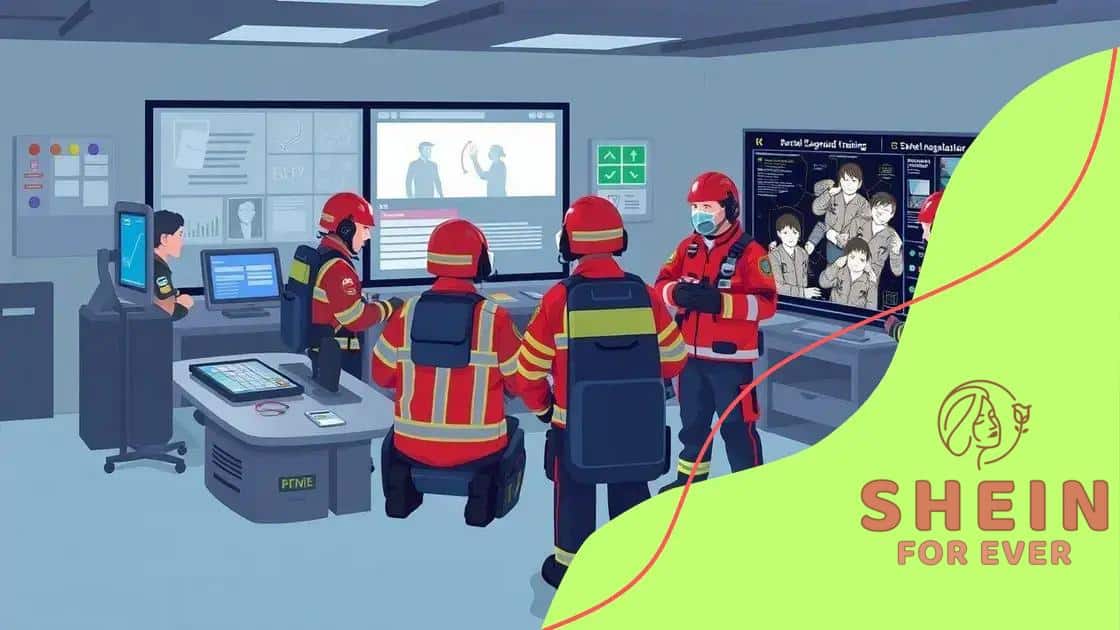The role of AI simulations in disaster response management

The role of AI simulations in disaster response management is crucial for enhancing preparedness, improving response times, and ensuring effective training for responders through real-time data analysis and predictive capabilities.
The role of AI simulations in disaster response management cannot be underestimated. They serve as crucial tools that can enhance preparedness and save lives during emergencies. Have you ever wondered how technology can reshape our ability to respond to natural disasters?
Understanding AI simulations in disaster scenarios
Understanding AI simulations in disaster scenarios is essential for improving our emergency response capabilities. These simulations help teams prepare for real-life events by providing a safe space to practice tactics and strategies. Utilizing artificial intelligence, responders can analyze past disasters and model various outcomes, leading to better decision-making during actual emergencies.
How AI Simulations Work
AI simulations use complex algorithms to create realistic scenarios. By inputting data from previous disasters, they can replicate the conditions and challenges emergency responders might face. This technology is not just theoretical; it involves real data and relies on input from experts in the field.
Furthermore, these simulations can adapt over time. As new data becomes available or as technology evolves, the AI systems can refine their predictions and strategies, offering continuous improvement for disaster response efforts.
Benefits of AI in Disaster Training
- Realistic training experiences: Responders practice in an environment that mimics real-life challenges.
- Data-driven insights: AI provides analytical feedback that can lead to improved strategies.
- Time-saving: Simulations can generate multiple scenarios quickly, allowing for more training in less time.
- Team collaboration: Emergency responders can work together in a simulated setting, enhancing team dynamics.
Understanding these aspects of AI simulations is vital. They not only prepare teams for what they might face but also foster confidence and cooperation among responders. By simulating various disaster scenarios, agencies can pinpoint weaknesses in their plans and make necessary adjustments before a real event occurs. During training, participants can reflect on their performances, discussing what worked and what didn’t, which is essential for continual learning and adaptation.
The real strength of AI simulations lies in their ability to forecast possible impacts and suggest strategic responses. In the midst of a disaster, having technology capable of processing information and providing insights can significantly enhance operational effectiveness.
By adopting AI simulations, agencies can shift from a reactive approach to a proactive one. This transition is critical as it paves the way for smarter, faster, and more efficient emergency management.
Real-world applications of AI in emergency management
Real-world applications of AI in emergency management significantly enhance how responders tackle crises. By utilizing artificial intelligence, emergency services can make quicker and more informed decisions during disasters. This technology processes vast amounts of data in real-time, providing crucial insights that improve safety and effectiveness.
Predictive Analytics for Disaster Preparedness
One major application of AI is predictive analytics. By analyzing patterns from historical data, AI can forecast potential disasters, such as floods or wildfires. This enables agencies to allocate resources more efficiently and prepare communities in advance.
- Risk assessment: AI helps identify areas most at risk, allowing for targeted strategies.
- Resource allocation: Emergency services can deploy equipment and personnel effectively based on predictions.
- Public warnings: AI systems can generate alerts for residents at risk, improving public safety.
Additionally, AI can assist in real-time situation monitoring. During a disaster, AI tools analyze on-the-ground conditions using data from drones, social media, and sensors. This capability enables responders to adapt strategies as situations evolve, ensuring they remain effective under pressure.
AI-Driven Decision Support Systems
An emerging trend is the use of AI-driven decision support systems. These systems aid commanders in evaluating multiple scenarios simultaneously, presenting options for optimal responses. They consider various factors, such as weather conditions and resource availability. This greatly enhances situational awareness for decision-makers.
Moreover, AI helps improve training programs for responders. By simulating real-life emergencies, agencies can prepare their teams for the unexpected. Participants gain hands-on experience with strategic decision-making and collaboration, building confidence for when real disasters occur.
Emergency management agencies worldwide are increasingly adopting AI solutions. From optimizing search and rescue operations to enhancing crisis communication, the real-world applications of AI are vast. Each implementation brings us closer to more resilient communities ready to face emergencies head-on.
Benefits of using simulations for response training

Using simulations for response training offers numerous benefits that enhance preparedness for emergency situations. These simulations create controlled environments where responders can practice their skills without the risks associated with real scenarios. This approach promotes a deeper understanding of protocols and procedures needed during a crisis.
Enhanced Skill Development
One of the primary advantages of simulations is the enhancement of skills. Participants engage in realistic scenarios that challenge their decision-making and critical thinking abilities. This hands-on experience helps them retain knowledge better and apply techniques more effectively in the field.
- Real-time feedback: Instructors can provide immediate assessments, allowing responders to adjust their approaches.
- Team coordination: Simulations foster collaboration, helping teams work together seamlessly under pressure.
- Adaptability training: Responders learn to adjust their strategies based on evolving circumstances.
In addition, simulations allow teams to identify areas where they need improvement. After each session, participants can review their performance and discuss alternative strategies. This continuous feedback loop enhances their overall competence and confidence during actual incidents.
Increased Familiarity with Technology
Modern simulations often incorporate advanced technologies, such as virtual reality and AI tools. These technologies offer realistic experiences that make training more immersive. Familiarity with these tools is crucial since many emergency services rely on technology during real emergencies.
Moreover, responding to emergencies today often involves understanding and utilizing communication systems efficiently. Simulated training allows responders to practice using these tools, ensuring a smoother operation in real-world situations.
Simulations also help build a culture of preparedness within agencies. When responders train together regularly, they develop trust and teamwork, essential elements for effective emergency management. This training promotes a proactive approach to community safety.
The continual advancement of simulations means that emergency response teams can always refine their skills. By embracing simulation-based training, agencies prepare their personnel to face challenges head-on and improve outcomes for the communities they serve.
Challenges in implementing AI simulations
Implementing AI simulations in emergency management presents several challenges that organizations must navigate. While these simulations offer significant advantages, the path to effective implementation is not always straightforward. Understanding these obstacles is crucial for maximizing the benefits of AI technologies.
Technical Difficulties
One of the main challenges is the technical complexity of developing and integrating AI systems. Building simulations that accurately reflect real-world scenarios requires extensive data and sophisticated algorithms. Not all organizations have access to the necessary technical expertise or resources.
- Data quality: Poor-quality data can lead to unreliable simulations, resulting in flawed training experiences.
- Integration issues: Merging AI simulations with existing systems can be problematic and time-consuming.
- Maintenance: Continuous updates and maintenance are crucial to ensure the technology remains effective.
Moreover, as AI technologies rapidly evolve, first responders must stay updated. This demand for ongoing education places an additional burden on organizations, which can limit the frequency and quality of training.
Cost Considerations
The costs associated with implementing AI simulations can be high. Organizations need not only the software but also the hardware and infrastructure to support these systems. Budget constraints often make it difficult for some agencies to adopt these advanced technologies.
Additionally, there may be hidden costs related to training personnel to use the new systems effectively. Many agencies find it challenging to allocate sufficient funds for both initial implementation and ongoing training.
Cultural Resistance
Another barrier is the cultural resistance within organizations. Some personnel may be hesitant to embrace new technologies, preferring traditional methods of training. This reluctance can undermine the potential success of AI simulations.
Encouraging a culture of innovation and flexibility is crucial for overcoming resistance. Leadership must actively promote the benefits of AI and demonstrate its value in enhancing emergency response capabilities.
Despite these challenges, the potential rewards of implementing AI simulations are significant. By addressing these obstacles head-on, organizations can harness the full potential of these technologies for better emergency management outcomes.
Future trends in AI for disaster readiness
Future trends in AI for disaster readiness promise to transform emergency management significantly. As technology continues to advance, we can expect more sophisticated solutions that enhance our ability to respond to crises effectively. These developments focus not only on immediate responses but also on long-term preparedness and resilience.
Integration of AI with IoT
One major trend is the integration of AI with the Internet of Things (IoT). This combination allows for smarter disaster response systems. IoT devices can collect real-time data on environmental conditions, while AI analyzes this information to predict potential disasters. For example, sensors can monitor changes in weather patterns, alerting authorities before a storm intensifies.
- Improved monitoring: Continuous data collection enhances situational awareness.
- Predictive capabilities: AI can forecast disasters with greater accuracy.
- Rapid response: Integrated systems can trigger alerts automatically, improving reaction times.
The integration of these technologies can significantly mitigate the impacts of disasters by allowing communities to act swiftly and efficiently.
Personalized Emergency Management
Another exciting trend is the move toward personalized emergency management. AI can help tailor responses based on individual needs, enhancing safety and preparedness for diverse populations. For instance, using data analysis, emergency services can provide customized information to vulnerable groups, ensuring they have the resources needed during disasters.
This personalized approach also extends to training scenarios, where responders can receive tailored simulations based on their specific roles and expertise. This focused training helps ensure that all team members are optimally prepared for their responsibilities.
Enhanced AI Algorithms
As research continues, we will also see enhanced AI algorithms capable of processing larger datasets efficiently. These next-generation algorithms will improve the accuracy of simulations and the reliability of predictions. Machine learning models will not only analyze past data but also adapt and learn from new information quickly.
Furthermore, advancements in natural language processing will facilitate better communication during emergencies. AI systems will be able to understand and translate information across multiple languages, allowing for clearer communication among diverse populations.
In conclusion, the future trends in AI for disaster readiness highlight the potential for transformative changes in emergency management. By embracing these advancements, we can enhance preparedness, improve response times, and ultimately save lives.
FAQ – Common Questions about AI in Disaster Readiness
How does AI improve disaster response times?
AI analyzes data in real-time, allowing emergency responders to make quick decisions and implement effective strategies during crises.
What role does IoT play in disaster management?
IoT devices collect and share data about environmental conditions, which AI processes to predict potential disasters, enhancing preparedness.
Can AI simulations aid in training emergency responders?
Yes, AI simulations provide realistic training scenarios, helping responders develop critical skills and improve team coordination.
What are the challenges of implementing AI in emergency management?
Challenges include technical complexity, high costs, and cultural resistance within organizations, but overcoming these can lead to significant improvements.






